ECUADOR HIGHLANDS TOUR
12 Days, 11 Nights
Feb 12 – 23, 2014
See the beauty and wonder of the Ecuador highlands and its people close up. Taste fresh exotic (and familiar) fruit juices, soak in the hot mineral springs of an active volcano, catch breath-taking views on a train as it snakes down the edge of the Andes mountains, visit authentic Ecuador markets, sit in solitude inside a majestic cathedral, and enjoy the grandeur of the Andes mountains.
DETAILED SCHEDULE
The Ecuador culture is full of surprises. Schedules and organized plans don’t always happen with the certainty and timeliness of our U.S. culture. Therefore, the proposed schedule below is subject to changes and surprises and also to weather and travel conditions.
Feb 12 WED Fly to Guayaquil
Feb 13 THU Morning in Guayaquil, drive to Cuenca through El Cajas National Park
Feb 14 FRI Cuenca Markets, churches, plazas, museum of culture in afternoon
Feb 15 SAT Drive to Chordeleg and then to Ingapirca, Ingapirca ruins
Feb 16 SUN Drive to Aluasi, Devils Nose Train, drive to Riobamba
Feb 17 MON Riobamba in morning, lunch at ranch, then drive to Banos
Feb 18 TUE Banos (Manto de la Novia /El Pailon del Diablo), afternoon explore Banos
Feb 19 WED Drive to Quito in morning, afternoon in Old Town Quito
Feb 20 THU Old Town or Teleferico in morning, then to Mitad del Mundo and Otavalo
Feb 21 FRI Drive to San Antonia de Ibarra (woodcarving), Cuicocha Lake, Peguchi
Feb 22 SAT Otavalo market in morning, waterfalls in afternoon
Feb 23 SUN Return to Quito Airport and fly home
Day 1: Flight from New York to Guayaquil, Ecuador.
We will fly into Guayaquil, the largest city of Ecuador near the coast in southern Ecuador. Founded in the 1530’s, Guayaquil is the main port of Ecuador and home to a bustling import-export business. We will spend our first night in Guayaquil.
Day 2: Guayaquil and Cuenca
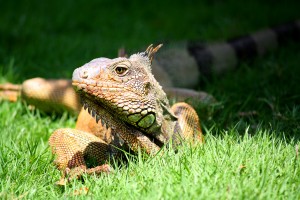 In the morning, you will have opportunity to walk along the Malecon 2000, a lively boardwalk along the Rio Guayas. You may also visit the Seminary Park (Iguanas Park) in downtown Guayaquil where hundreds of iguanas live in trees. In the center of the park is the Statute of Simon Bolivar. There is also the Metropolitan Cathedral of Guayaquil which has beautiful semi-Gothic towers. Enjoy the wrmth of Guayaquil before we drive to the highlands.
In the morning, you will have opportunity to walk along the Malecon 2000, a lively boardwalk along the Rio Guayas. You may also visit the Seminary Park (Iguanas Park) in downtown Guayaquil where hundreds of iguanas live in trees. In the center of the park is the Statute of Simon Bolivar. There is also the Metropolitan Cathedral of Guayaquil which has beautiful semi-Gothic towers. Enjoy the wrmth of Guayaquil before we drive to the highlands.
In the afternoon, we will drive to Cuenca (about a four hour drive), passing through Parque Nacional Cajas, a national park in the highlands of Ecuador, between 3100m and 4450m above sea level, about 30 km west of Cuenca,. It offers a tundra vegetation on a jagged landscape of hills and valleys with about 270 lakes and lagoons. Many of the lakes are of glacial origin leaving U-shaped valleys and ravines. The park offers breathtaking scenery, fauna and flora, straddling the continental divide. Be prepared to put on sweaters and jackets due to high altitude and temperatures in the 40’s and 50’s.
Day 3: Cuenca
Cuenca is a charming old city with its cobblestone streets, old-world cathedrals, colonial parks and rivers. Cuenca is the capital of the Azuay province, the third largest city in Ecuador, and the economic center of the southern Sierra. These distinctions, along with the city’s incredibly well preserved history, recently earned Cuenca the honor of being listed as a UNESCO World Heritage Trust site.
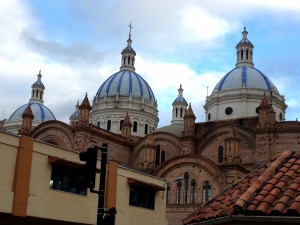 The morning is free to explore Parque Calderon, Cuenca’s central square and main plaza. Manicured trees tower over men discussing politics, grandmothers walking arm-in-arm, and children eating ice cream. Be sure to visit the impressive New Cathedral (Catedral de la Inmaculada) and its towering blue domes which can be seen all over Cuenca.
The morning is free to explore Parque Calderon, Cuenca’s central square and main plaza. Manicured trees tower over men discussing politics, grandmothers walking arm-in-arm, and children eating ice cream. Be sure to visit the impressive New Cathedral (Catedral de la Inmaculada) and its towering blue domes which can be seen all over Cuenca.
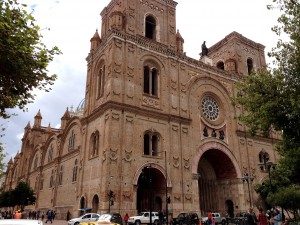 Construction of the New Cathedral was begun in 1885 and, after numerous stops and starts, was finally finished in 1967. The Cathedral is made of alabaster and marble. Its floor is made of pink marble imported from Italy. Both Romance and Baroque are prominent in the architecture. Walk inside and take a few minutes to sit and meditate or join those in prayer.
Construction of the New Cathedral was begun in 1885 and, after numerous stops and starts, was finally finished in 1967. The Cathedral is made of alabaster and marble. Its floor is made of pink marble imported from Italy. Both Romance and Baroque are prominent in the architecture. Walk inside and take a few minutes to sit and meditate or join those in prayer.
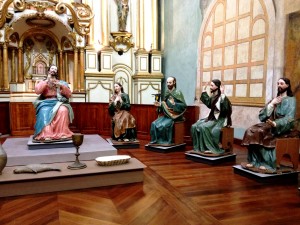 On the opposite side of the park is the Old Cathedral ( El Sagrario). Admission is $2.00, but well worth it! Inside is a magnificent depiction of the Last Supper with life-size statues of Jesus and the disciples. If you ask, you can go upstairs, behind the scenes and see an antique organ with its large bellows requiring several men to operate to provide the required air for the organ. You can also climb the old bell tower up narrow winding steps. Other art and sculptures are also inside.
On the opposite side of the park is the Old Cathedral ( El Sagrario). Admission is $2.00, but well worth it! Inside is a magnificent depiction of the Last Supper with life-size statues of Jesus and the disciples. If you ask, you can go upstairs, behind the scenes and see an antique organ with its large bellows requiring several men to operate to provide the required air for the organ. You can also climb the old bell tower up narrow winding steps. Other art and sculptures are also inside.
Other nearby churches include the Church of San Francisco and the Church of Santo Domingo – the second largest church in the city, boasting twin 40-meter high brick towers and a beautiful facade. It’s located at Gran Colombia and Padre Aguirre.
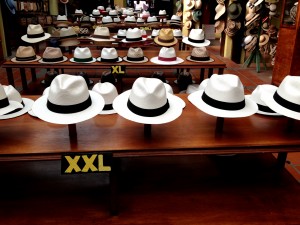 A walk down to the river will take you to Barranco’s Panama Hat Factory where high quality panama hats have been made for the last 68 years. The museum provides daily tours to the public on the past and current ways of producing the different kinds of panama hats. Panama Hats do not originate in Panama, but in Ecuador and are traced back to the 17’th century. The hats were taken to Panama for shipping to Europe, Asia and the Americas. Subsequently they acquired a name that reflected their point of international sale, “Panama hats”, rather than their place of domestic origin.
A walk down to the river will take you to Barranco’s Panama Hat Factory where high quality panama hats have been made for the last 68 years. The museum provides daily tours to the public on the past and current ways of producing the different kinds of panama hats. Panama Hats do not originate in Panama, but in Ecuador and are traced back to the 17’th century. The hats were taken to Panama for shipping to Europe, Asia and the Americas. Subsequently they acquired a name that reflected their point of international sale, “Panama hats”, rather than their place of domestic origin.
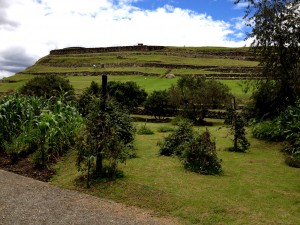 In the afternoon, we will visit the Museo de las Culturas Aborígenes – a fascinating museum that houses a private collection of 5,000 archeological pieces representing over 20 pre-Columbian indigenous cultures of Ecuador and their 15,000 years of existence. It holds fascinating pieces from the first indigenous civilizations in Ecuador. In the grounds outside the museum, there are Inca Ruins. Though the Spanish destroyed all the complete structures when they built Cuenca, interesting walls and stonework remain. There are demonstrations of farming that revolve around the worship of the sun.
In the afternoon, we will visit the Museo de las Culturas Aborígenes – a fascinating museum that houses a private collection of 5,000 archeological pieces representing over 20 pre-Columbian indigenous cultures of Ecuador and their 15,000 years of existence. It holds fascinating pieces from the first indigenous civilizations in Ecuador. In the grounds outside the museum, there are Inca Ruins. Though the Spanish destroyed all the complete structures when they built Cuenca, interesting walls and stonework remain. There are demonstrations of farming that revolve around the worship of the sun.
Day 4: Ingapirca Ruins
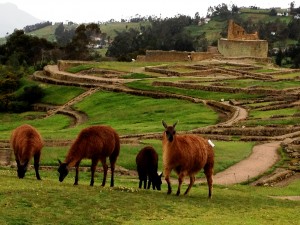 Today, we will drive north about two hours to Ingapirca and visit the Ingapirca Ruins, the largest known Inca ruins in Ecuador. The most significant building is the temple of the sun, an elliptically shaped building constructed around a large rock. The temple of the sun was positioned so that on the solstices, at exactly the right time of day, sunlight would fall through the center of the doorway of the small chamber at the top of the temple. They also developed a complex underground aqueduct] system to provide water to the entire compound.
Today, we will drive north about two hours to Ingapirca and visit the Ingapirca Ruins, the largest known Inca ruins in Ecuador. The most significant building is the temple of the sun, an elliptically shaped building constructed around a large rock. The temple of the sun was positioned so that on the solstices, at exactly the right time of day, sunlight would fall through the center of the doorway of the small chamber at the top of the temple. They also developed a complex underground aqueduct] system to provide water to the entire compound.
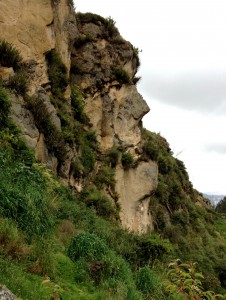 The Incas were not the first inhabitants of Ingapirca. It had long been settled by the Canari indigenous people who constructed a Temple where they worshiped the moon. The Canari and Inca cultures had many differences. The Incas worshiped the sun, the Canari worshiped the moon. The Incas honored and celebrated the masculine. The Canari honored and celebrated the feminine. The Incas had kings, the Canari had queens. At first, their cultures clashed, but eventually they decided to settle their differences and live together peacefully in a unique blend of cultures, until the Spanish came.
The Incas were not the first inhabitants of Ingapirca. It had long been settled by the Canari indigenous people who constructed a Temple where they worshiped the moon. The Canari and Inca cultures had many differences. The Incas worshiped the sun, the Canari worshiped the moon. The Incas honored and celebrated the masculine. The Canari honored and celebrated the feminine. The Incas had kings, the Canari had queens. At first, their cultures clashed, but eventually they decided to settle their differences and live together peacefully in a unique blend of cultures, until the Spanish came.
In the afternoon, you will have time to relax, walk to the village, or take short hikes to a large rock overlooking the valley or to a large rock boulder shaped in the form of a human face.
Day 5: Aluasi Devil’s Nose Train, Riobamba
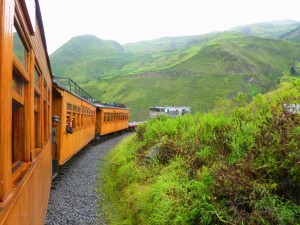 Today, we will drive another 1-2 hours north in the Andes mountains to Aluasi where we will take the Devil’s Nose train ride (Nariz del Diablo). This is one of the most scenic train rides in the world and was originally formed as part of the Trans-Andean Railroad. This is the steepest train track in the world as it zigzags along the edge of the Andes in a truly exhilarating and exciting ride. At the bottom we will enjoy sandwiches, traditional music and dancing, and the opportunity to purchase souvenirs from the locals, before ascending back to the top. We will then drive north to Riobamba, passing through more beautiful highlands of Ecuador. If time, we will stop by the oldest Catholic chapel in the country “Balbanera chapel”.
Today, we will drive another 1-2 hours north in the Andes mountains to Aluasi where we will take the Devil’s Nose train ride (Nariz del Diablo). This is one of the most scenic train rides in the world and was originally formed as part of the Trans-Andean Railroad. This is the steepest train track in the world as it zigzags along the edge of the Andes in a truly exhilarating and exciting ride. At the bottom we will enjoy sandwiches, traditional music and dancing, and the opportunity to purchase souvenirs from the locals, before ascending back to the top. We will then drive north to Riobamba, passing through more beautiful highlands of Ecuador. If time, we will stop by the oldest Catholic chapel in the country “Balbanera chapel”.
DAY 6 Riobamba, Ranch, drive to Banos
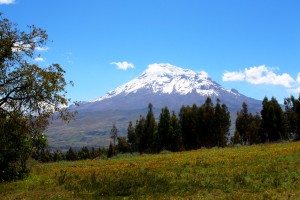 We will be hosted for lunch by our Ecuador friends and family on a ranch with a beautiful view of Chimborazo, Ecuador’s highest mountain, if the clouds allow us. Enjoy a hike around this working ranch with horses, cows, goats, and traditional crops. Enjoy a traditional indigenous lunch made in an outdoor oven of coi (guinea pig), chicken, potatoes, and roasted corn. We will then continue our scenic drive to Banos.
We will be hosted for lunch by our Ecuador friends and family on a ranch with a beautiful view of Chimborazo, Ecuador’s highest mountain, if the clouds allow us. Enjoy a hike around this working ranch with horses, cows, goats, and traditional crops. Enjoy a traditional indigenous lunch made in an outdoor oven of coi (guinea pig), chicken, potatoes, and roasted corn. We will then continue our scenic drive to Banos.
DAY 7 Banos – Hot Springs, Waterfalls, hiking, cathedral (Banos)
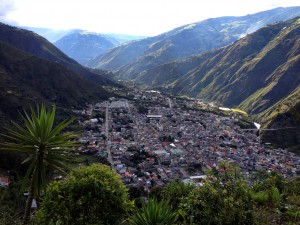 Baños is a small town in the Andean highlands, at the edge of the Amazon jungle, sitting under the smoke of the active volcano Tungurahua. Baños, which is Spanish for “Baths (of sacred water),” comes from the famous hot springs in the area. The cathedral has beautiful paintings depicting stories of the Virgin saving the town from the fiery volcano.
Baños is a small town in the Andean highlands, at the edge of the Amazon jungle, sitting under the smoke of the active volcano Tungurahua. Baños, which is Spanish for “Baths (of sacred water),” comes from the famous hot springs in the area. The cathedral has beautiful paintings depicting stories of the Virgin saving the town from the fiery volcano.
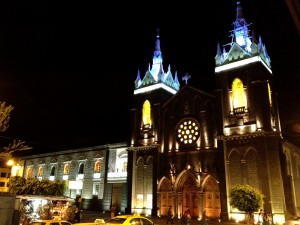 In the morning, you have the option of visiting some beautiful waterfalls near Banos such as Manto de la Novia and El Pailon del Diablo. Those who love adventure can zip line over a river canyon or go bungee-jumping. You can also hike up to “The Virgin” for a great view of Banos. Or you can rent go carts or bicycles and explore the town on your own. Or you can just rest, relax and enjoy the beauty and culture of Ecuador. Soaking in the public hot baths are $3 and a cultural experience not to be missed. Or perhaps you want to relax with an inexpensive massage. Lodging will again be in Baños.
In the morning, you have the option of visiting some beautiful waterfalls near Banos such as Manto de la Novia and El Pailon del Diablo. Those who love adventure can zip line over a river canyon or go bungee-jumping. You can also hike up to “The Virgin” for a great view of Banos. Or you can rent go carts or bicycles and explore the town on your own. Or you can just rest, relax and enjoy the beauty and culture of Ecuador. Soaking in the public hot baths are $3 and a cultural experience not to be missed. Or perhaps you want to relax with an inexpensive massage. Lodging will again be in Baños.
DAY 8 Banos – Quito – Old Town (Quito)
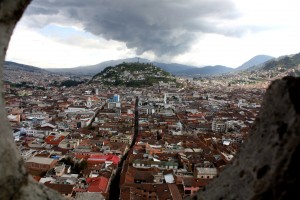 This morning, we will drive to Quito, the capital city of Ecuador, located at 9,348 feet, 14 miles south of the equator, nestled in a valley surrounded by the Andes Mountains. On a clear day, several snow-capped volcanoes are visible from the city. In the afternoon, you can explore historic Old Town Quito, declared a UNESCO World Heritage Site in1978, and considered the location with the largest accumulation of art treasures in South America.
This morning, we will drive to Quito, the capital city of Ecuador, located at 9,348 feet, 14 miles south of the equator, nestled in a valley surrounded by the Andes Mountains. On a clear day, several snow-capped volcanoes are visible from the city. In the afternoon, you can explore historic Old Town Quito, declared a UNESCO World Heritage Site in1978, and considered the location with the largest accumulation of art treasures in South America.
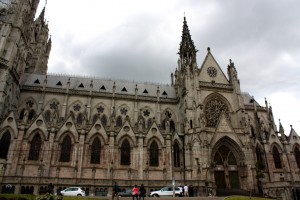 Visit the Plaza de la Independencia where you find the Cathedral and Presidential Palace, the unique Jesuit La Compañia de Jesus church famous for its gold leafed interiors containing 1 ½ tons of gold, San Francisco Square and church, and the grand neo-gothic Basilica. Those who are unafraid of heights have the opportunity to climb ladders to scale the basilica’s tower – a braveness rewarded with a view over the city of Quito!
Visit the Plaza de la Independencia where you find the Cathedral and Presidential Palace, the unique Jesuit La Compañia de Jesus church famous for its gold leafed interiors containing 1 ½ tons of gold, San Francisco Square and church, and the grand neo-gothic Basilica. Those who are unafraid of heights have the opportunity to climb ladders to scale the basilica’s tower – a braveness rewarded with a view over the city of Quito!
DAY 9 Quito – Mitad del Mundo – Otavalo (Otavalo)
In the morning, if the weather cooperates, you may have an opportunity to take a gondola lift, running from the edge of the city centre up the east side of Pichincha Volcano to lookout Cruz Loma, one of the highest aerial lifts in the world, rising from 3,117 m (10,226 ft) to 3,945 m (12,943 ft). At the summit there are trails and stunning views. Be aware that this is very high altitude. You may also continue to explore Old Town Quito.
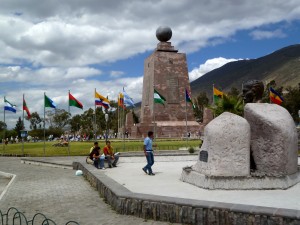 Late morning, we will drive north to visit Mitad del Mundo. The country of Ecuador is named after the imaginary line that divides the planet into the northern and southern hemispheres. The Equator passes just twenty kilometres to the north of Quito where for a short distance it exists as a real line and you can stand in both hemispheres at once. We then continue north through the highlands to Otavalo.
Late morning, we will drive north to visit Mitad del Mundo. The country of Ecuador is named after the imaginary line that divides the planet into the northern and southern hemispheres. The Equator passes just twenty kilometres to the north of Quito where for a short distance it exists as a real line and you can stand in both hemispheres at once. We then continue north through the highlands to Otavalo.
DAY 10 Woodcarving Village – Cuicocha Lake – Leather Village
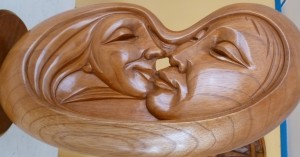 Today, we will visit San Antonio De Ibarra, a village where the people are known for their exquisite woodcarvings. As you wander in and out of the shops, you will see many unique carvings as well as craftsmen at work. Stop by the museum on the square with amazing masterpieces. We may also stop at the town of Cotacachi, a small town that specializes in leather working and has become a well-known retirement home for many.
Today, we will visit San Antonio De Ibarra, a village where the people are known for their exquisite woodcarvings. As you wander in and out of the shops, you will see many unique carvings as well as craftsmen at work. Stop by the museum on the square with amazing masterpieces. We may also stop at the town of Cotacachi, a small town that specializes in leather working and has become a well-known retirement home for many.
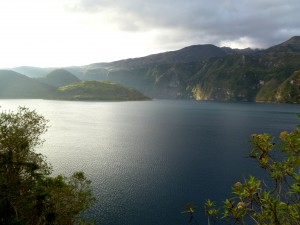 After lunch, we will drive to the volcanic crater lake of Cuicocha, the “lake of the gods”. Enjoy beautiful views from the rim trail, or from a boat tour on the lake, or just enjoy the view from the café. Usually you can enjoy live traditional music of Ecuador while you relax and overlook the lake. If there is time, we will visit a village that makes many leather products or a village of weavers.
After lunch, we will drive to the volcanic crater lake of Cuicocha, the “lake of the gods”. Enjoy beautiful views from the rim trail, or from a boat tour on the lake, or just enjoy the view from the café. Usually you can enjoy live traditional music of Ecuador while you relax and overlook the lake. If there is time, we will visit a village that makes many leather products or a village of weavers.
DAY 11 Otavalo – Market, Waterfalls
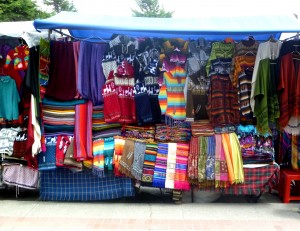 On Saturday, Otavalo comes alive as almost one third of the town becomes full of local vendors selling textiles, jewelry, musical instruments, leather goods, weavings, hammocks, indigenous costumes, hand-painted platters, purses, hand-knitted wool sweaters, straw hats, clothing, spices, raw foods, spools of wool, and much more! Browse, barter, and buy to your heart’s content. This is one of the largest and most colorful indigenous markets in Latin America and one of the best places to buy authentic Ecuador items. The market dates back to pre-Incan times when jungle products were transported from the eastern lowlands and traded for highland goods. One of the most evident features of the Otavalo culture is their colorful traditional dress.
On Saturday, Otavalo comes alive as almost one third of the town becomes full of local vendors selling textiles, jewelry, musical instruments, leather goods, weavings, hammocks, indigenous costumes, hand-painted platters, purses, hand-knitted wool sweaters, straw hats, clothing, spices, raw foods, spools of wool, and much more! Browse, barter, and buy to your heart’s content. This is one of the largest and most colorful indigenous markets in Latin America and one of the best places to buy authentic Ecuador items. The market dates back to pre-Incan times when jungle products were transported from the eastern lowlands and traded for highland goods. One of the most evident features of the Otavalo culture is their colorful traditional dress.
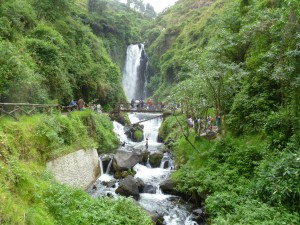 In the afternoon we will visit the Peguchi Waterfall just outside of Otavalo. A short hike to the waterfall leads through a beautiful forest. If time, we may visit the nearby weaving village of Peguchi, where you can meet master weavers and learn about traditional musical instruments that originate from the Andes. Depending on what time the flight leaves the next day, we may stay in Otavalo or we will drive to Quito where we spend our last night in Ecuador.
In the afternoon we will visit the Peguchi Waterfall just outside of Otavalo. A short hike to the waterfall leads through a beautiful forest. If time, we may visit the nearby weaving village of Peguchi, where you can meet master weavers and learn about traditional musical instruments that originate from the Andes. Depending on what time the flight leaves the next day, we may stay in Otavalo or we will drive to Quito where we spend our last night in Ecuador.
DAY 12 Flight home
Today, we will drive to the Quito airport and return to New York, departing Ecuador and leaving behind a beautiful country, new friends, and taking with us unforgettable memories.
ESTIMATED COST:
$2,950 for 11 days, 10 nights. Supplement for single room is $275.
The cost is based on current costs may fluctuate based on oil prices and flight costs.
WHAT IS INCLUDED
• Round trip flight to Ecuador from New York area
• Group Transportation in Ecuador
• Eleven nights lodging in Ecuador
• Breakfast plus one additional meal per day except for travel days to and from the U.S.
• Admission to Mitad del Mundo, Quito Teleferico, Quenca Cultural Museuem
• Admission to the Ingapirca Ruins, Devil’s Nose Train Ride
WHAT IS NOT INCLUDED
• Transportation from your home to JFK airport and back to your home
• Group transportation can be arranged to and from the airport.
• Other museums or attractions you choose to visit on your own.
• Any special activities or services such as rafting, bungee jumping, zip-lining, hot baths, massages, etc.
• Any special taxi transportation services you may choose.
• Souvenirs, snacks, drinks, and other personal expenses you incur on the trip.
• Basic Travel Insurance

